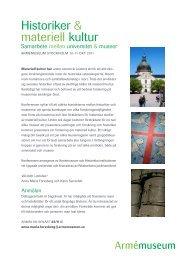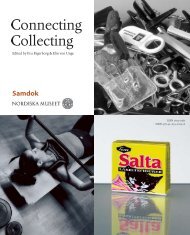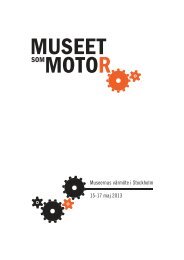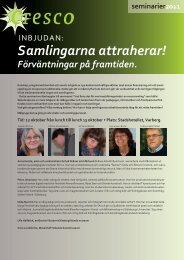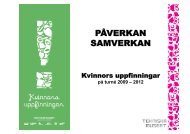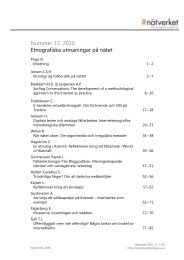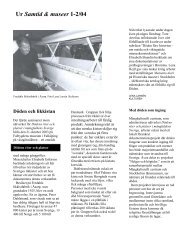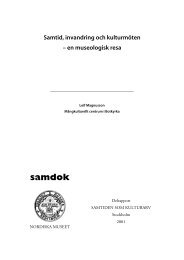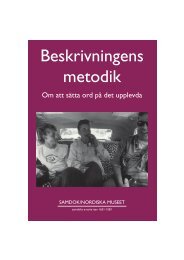The Pool for Management of Natural ResourcesNature– an exploited heritageWhat do living conditions in a village in northern Sweden have in common with silos under threatof demolition in Västergötland? What links cultural tourism with the move of a whole town? Thecommon denominator is how people use the resources provided by nature, the very preconditionsfor our survival – and the field studied by the Pool for Management of Natural Resources.By Ann-Katrin Wahss and Eva Gradin»The pool investigates and documentsthe use of nature in Sweden– land, forest, water, and minerals. Thework of the pool is closely connected tothe times and the political decisions thataffect us all. The Samdok studies illuminatehow these decisions affect peopleand the landscape and are importantboth for posterity and in contemporarysociety. This article gives some examplesof projects that have been conducted inrecent years.The consequences of our electricityneedsGallejaur is a village in the forest on theboundary between the counties of Norrbottenand Västerbotten. Here NorrbottenMuseum was commissioned by theCounty Administration in Norrbottento carry out an ethnological interviewstudy and photographic documentationduring an annual cycle, 2000–2001. Gallejaur,which in many contexts is describedas a forest village that is unique tonorthern Sweden, has been radically hitby the effects of our industrial society.The conditions for the village’s livelihooddisappeared with the construction ofthe Gallejaur power station in 1960–64.Almost all arable land and cultivated bogwas placed under water, when the lakeGallejaursjön was transformed into aregulating barrage. The shoreline camealmost 100 metres closer to the villagesettlement. Today only three farms areoccupied in the winter, but during thesummer the village comes to life, whenrelatives return to the farms that are nowholiday homes.The study focused on how the villagehas been shaped as a local culturalenvironmentsystem and was carried outto provide information for an inquiryinto the possibility of forming a culturereserve.People and their buildings was thetopic chosen in order to shed light onthe village’s development and change. Tofind causal connections between the village’sorigin, development, and presentappearance, the project involved notonly interviews with villagers but alsostudies at the Environmental Court inUmeå and the Land Survey Authority inLuleå. The study describes the developmentfrom a new settlement, marked outin 1801, to a village whose existence hasbeen radically affected by the needs forelectricity in the industrial society. Theassignment has been presented in a publicationand a travelling exhibition.At the County Administration negotiationsare now in progress with theproperty owners about compensationfor trespass, and the hope there is that adecision to make Gallejaur a culture reservecan be made during 2008.Moving a townNorrbotten Museum is also involvedin following the move of large partsof the town of Kiruna. In the comingdecade, much of the town centre has toSilo in Vara. Photo Thomas Carlquist©Västergötland Museum.be moved because a large body of ironore is to be extracted, with the risk ofundermining the buildings and causingcollapses. Here the use of natureis dramatically confronted with humanliving environments. In preparationfor the inevitable transformation ofthe town, the museum is performing asurvey and analysis during 2007 of theevaluations that different local, regional,and national actors make of the town asa cultural environment. The study willprovide a foundation for decisions thathave to be made about Kiruna’s futureurban environment.How will the move take place? Whatdo people think when they move? Whatis given priority? The pool is discussingthe possibility of holding a field seminarin Kiruna once the moving process hasgot started.The agrarian memorialsof modernismWhat happens to the buildings thatare no longer needed for agriculture?14 • Samtid & museer no 2/07
The Pool for Management of Natural ResourcesGallejaur. Photo Daryoush Tahmasebi© NorrbottenMuseum.During 2004–2005 Västergötland Museum,in collaboration with VästraGötaland Regional Museum, conducteda survey of silos, the tall storage towersfor grain that set their mark on the landscapein many places. Some silos wereinvestigated in detail, a history of thedevelopment of silos was compiled, anda survey of the current situation.This study was done in the nick oftime. In the very last minutes of 2005the agricultural organization Lantmännenproduced its own survey, OperationBlue Light, of the silos in its ownership.It shows that only a few of these “surplusbuildings” will be used in the future.Most of them will be demolished, butsome can perhaps be preserved as monumentsto a change in operations.The study of silos in western Swedenhas spawned successors in other parts ofthe country. Soon we may have a morecomprehensive survey of what Swedenlooked like before the great silo closurewas completed. What is interestingabout the silo study in western Swedenis that it put the focus on a type of buildingand agricultural activity in radicalchange. The study also created a foundationfor the decisions that have to betaken concerning these buildings in thenot too distant future.Meanings of nature for residentsand visitorsSurrounded by the Vindelfjällen naturereserve is the little community of Ammarnäs,which has gained attention forthe struggle over natural resources thathas been waged by different actors, bothlocal and non-local. Tourism has stoodagainst reindeer herding, conflicts haveraged over the rights to hunting andfishing, and relations between differentgroups have been fraught. Now solutionsare being found to the conflicts overnatural resources through local administrationand coordination in “the AmmarnäsCouncil”.To study today’s living conditions inthis village and views as to how land –the common resource – should be used,the Pool for Management of Natural Resourcesinvited other Samdok pools to afield seminar in August 2007. What arethe strategies for the village to survive,how do they see the future, what doesit mean to live in a nature reserve? Thefield seminar was organized by VästerbottenMuseum, which thereby acquireda larger circle of colleagues as partners indialogue, while simultaneously obtainingnew material.Museum farmsThe museum farms that can be foundat several museums in Sweden are alsointeresting for the work of the pool.How do the museums preserve the oldknowledge associated with the farms,and how can this be used in the presentand the future? The question of a sustainablesociety is highly relevant for allthose working with old farming techniques.The museum farms can be a bankof knowledge which could be useful ina new way in the work with tomorrow’ssociety.Cultural heritage in changeOther studies in recent years have dealtwith different aspects of agriculture.Uppland Museum, which has agricultureas one of its profile areas, hasdocumented a hypermodern byre withrobot milking facilities and is doing researchon how ideas about landscape,people, and countryside are expressedin political language, and about changesof generation and property transfers onfarms in Sweden, Estonia, and Hungary.The County Museum of Gotland iscurrently working on a project abouttourism, where farmhouse accommodationand alternative uses of outbuildingshave become new sources of income forfarmers. Another project concerns theextraction and production of lime, withthe focus on how this affects nature andthe environment.Interviews and photographic documentationfrom earlier Samdok studieshave also been used in research onagrarian history, as part of the sourcematerial for Jordbruket i välfärdssamhället1945–2000 (“Agriculture in the WelfareState”), volume 5 in a series on thehistory of Swedish agriculture (Flygare &Isacson 2003).The studies and other experiencesfrom local museum work are ventilatedcontinuously in the pool. We arrangelectures, study visits, and seminars, andthe pool serves as a resource for supplementaryeducation and networking forthe participating museums. We deal withcurrent issues and try to keep up withthe latest research. The pool for Managementof Natural Resources documentsa cultural heritage that is changing radically,and this work is very important forthe future. pAnn-Katrin Wahss is department head atVästergötland Museum and chair of the Poolfor Management of Natural Resources,ankie.wahss@vgregion.se.Eva Gradin is head antiquarian at NorrbottenMuseum, eva.gradin@nll.se.Samtid & museer no 2/07 • 15



